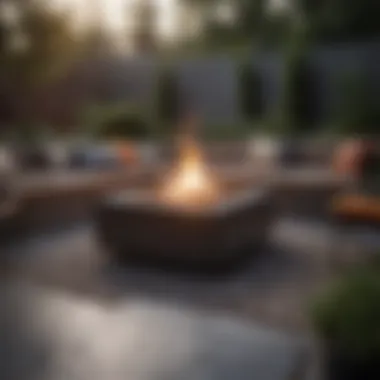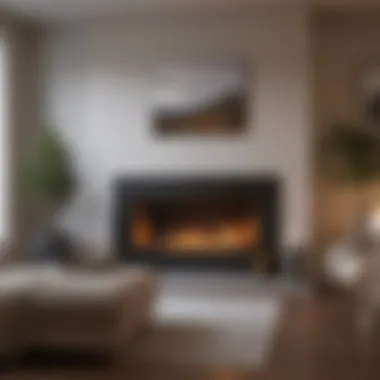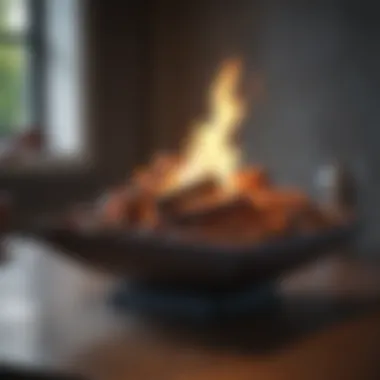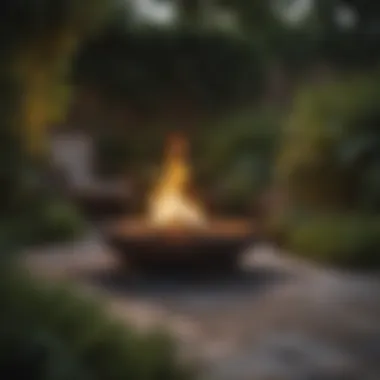Exploring Small Fire Features: Design and Aesthetics


Intro
In contemporary design, small fire features serve as crucial elements that harmonize function and aesthetics. Whether part of a backyard retreat or an inviting indoor space, these features enhance the overall ambiance while offering practical benefits. From fire pits to tabletop fireplaces, the range of options available today allows homeowners and designers to tailor fire features to unique environments. This article investigates their multifunctionality and aesthetic contribution, providing insights into selection, installation, and maintenance.
Design Inspirations
Trending Styles
The design of small fire features is evolving rapidly. Homeowners increasingly favor styles that reflect their personal taste and the environment in which they are installed. Modern designs, often characterized by clean lines and minimalistic forms, are gaining popularity. These features are typically sleek and unobtrusive, making them suitable for various settings, whether urban or rural.
Conversely, traditional designs often incorporate rustic elements such as stone or wood. A classic stone fire pit, for example, may evoke warmth and nostalgia, while still providing a focal point for any outdoor gathering.
In addition, contemporary hybrid forms are emerging, combining elements of both modern and traditional styles. These versatile options allow for personalization, addressing diverse aesthetic preferences while ensuring functionality remains paramount.
Color Palettes
When choosing a fire feature, the color palette plays a vital role in its overall impact. Earth tones, such as greys, browns, and greens, typically complement outdoor natural settings. Such biophilic hues create a seamless blend between the fire feature and its surroundings, making it feel like a natural extension of the environment.
For more urban settings, muted metallic colors like brushed steel or matte black may add a sleek, modern vibe. These shades contribute to a more contemporary aesthetic, aligning with modern design principles. Selecting an appropriate color palette can enhance the fire feature's ability to elevate the mood of the space, going beyond mere functionality.
According to interior design experts, integrating contrasting colors can also create a striking appearance. For instance, a bright red fire bowl may stand out against a monochromatic backdrop, drawing attention while enhancing the overall aesthetic appeal.
Maintenance and Upkeep
Seasonal Maintenance Checklist
Caring for small fire features ensures their longevity and performance. A seasonal maintenance checklist can assist in keeping them in top shape. Here are a few essential tasks:
- Inspect for wear and tear, focusing on gas lines and ignitions.
- Clean surfaces to remove ash and debris, which can accumulate over time.
- Check the surrounding area for flammable materials that could pose a hazard.
- Ensure proper ventilation is maintained if the fire feature is indoors.
- Store any removable components safely during adverse weather to prevent damage.
Cleaning and Organization Tips
Regular cleaning is paramount for safety and aesthetics. Here are some tips to consider:
- Use a soft brush or cloth to wipe down surfaces. Avoid abrasive materials that might scratch finishes.
- For gas fire features, periodically check burners for blockages. Using compressed air can help clear any found debris.
- Store fire tools in a designated area to avoid clutter. A visually appealing holder can contribute to the overall design of the space.
"Regular maintenance not only enhances the life of fire features but also ensures safety and optimal performance."
These considerations contribute not just to the feature's lifespan but also to an inviting environment that encourages use.
Integrating small fire features into home design is both a functional and aesthetic decision. They provide warmth, create intimate atmospheres, and adapt to personal tastes. With ongoing trends and continuous innovation in designs, implementing these features becomes an opportunity for homeowners to express themselves creatively.
Prelude to Small Fire Features
Small fire features have become a focal point in both indoor and outdoor design. Their significance extends beyond mere aesthetics; they serve practical purposes, enhancing the environment and overall experience. Through fire features, areas can transform into functional spaces that invite relaxation and social interaction. This section will explore key elements that define small fire features, their benefits, and aspects to consider when incorporating them into design.
Definition and Overview
Small fire features encompass a range of installations, such as fire pits, tabletop fireplaces, and built-in fireplaces. These installations can produce warmth, create ambiance, and provide a unique visual appeal. Typically, small fire features utilize gas, wood, or biofuels, allowing versatility in function and design.
The definition of small fire features implies a scale suitable for residential or limited spaces. Their localized nature allows them to fit seamlessly in patios, gardens, or even as indoor accents. Therefore, selecting an appropriate fire feature becomes crucial in ensuring it aligns with the desired use and surrounding landscape.
Historical Context
Historically, fire has been a core element of human habitats. From ancient civilizations that used open flames for cooking and warmth, to modern society’s gradual shift towards structured fire installations, the evolution is remarkable. Initially, fire pits were rudimentary, often left open and unguarded, creating both warmth and danger.
As architectural styles progressed, so did the concept of fire features. In the mid-20th century, advancements in material and design facilitated the rise of more sophisticated installations. Today, fire features are integrated into homes and commercial settings as both functional elements and stunning centerpieces. Their transition reflects broader trends in interior design focused on comfort, community, and connectivity with nature.
Types of Small Fire Features
The category of small fire features includes various designs that serve practical and aesthetic purposes. Understanding the different types helps homeowners, interior design enthusiasts, party hosts, and gardening aficionados make informed choices that align with their needs and style preferences. Each type comes with its own benefits and considerations, ensuring that buyers can find an option suitable for their specific environment. In essence, the prevalence of small fire features reflects a broader trend towards creating intimate and inviting spaces, indoors and outdoors.
Fire Pits
Fire pits are a quintessential element of outdoor living. They provide warmth and a place for social gatherings. Their versatility is one of the main reasons for their popularity. A fire pit can be built from a range of materials, including stone, brick, or metal. These options allow for customization that matches any backyard or patio design. Additionally, fire pits can burn different fuels, like wood or gas, making them adaptable for various preferences.


- Uses: Fire pits serve as gathering points for family and friends. They enhance outdoor spaces with warmth and light.
- Considerations: When installing a fire pit, size and placement are critical. Homeowners should ensure it is elevated from the ground to prevent accidents. Surrounding materials should be fire resistant.
The communal experience of gathering around a fire can strengthen relationships and create lasting memories.
Tabletop Fireplaces
Tabletop fireplaces are smaller, portable options suitable for both indoor and outdoor environments. These features offer a touch of elegance while providing warmth and ambiance. They are perfect for creating an intimate setting at dinner parties or outdoor lounge areas.
- Design: Available in various styles, the designs can complement existing decor or serve as a focal point.
- Fuel Type: Often powered by bioethanol, tabletop fireplaces provide a clean-burning alternative, making them suitable for indoor use without ventilation concerns.
Their compact nature allows for easy placement on a table or a patio, enhancing the overall aesthetic.
Built-In Fireplaces
Built-in fireplaces represent a more permanent installation option, both indoors and outdoors. They can be integrated seamlessly into walls or outdoor structures, adding sophistication to the space. This design option affords a vast array of material choices such as stone, tile, or concrete, letting homeowners create a tailored look.
- Functional Benefits: Built-in fireplaces deliver consistent heating and can often be designed to serve multiple purposes, such as cooking.
- Aesthetic Value: They can significantly increase property value and enhance the ambiance of a room. Proper installation is crucial to ensure safety and functionality.
The commitment to a built-in fireplace can be seen as an investment in comfort and style.
Portable Fire Features
Portable fire features have gained traction for their flexibility and convenience. These are typically lighter and less complex than permanent installations or built-ins. They can be moved to various locations based on need or preference.
- Types: Options range from small fire bowls to larger, movable fire carts equipped with wheels.
- Advantages: Portable fire features are particularly well-suited for those who enjoy hosting gatherings or want to change their space frequently. They are also often less expensive and easier to maintain than permanent fixtures.
Design Considerations
Design considerations are essential when one ventures into the world of small fire features. These elements are not just about beauty but also touch on functionality, safety, and the overall experience. Proper design ensures that a fire feature complements its surroundings, aligns with its intended use, and serves homeowners' or users' needs effectively. Factors such as size, material selection, and layout are critical in creating a successful small fire feature.
Size and Scale
When considering a small fire feature, size and scale are paramount. The dimensions of the fire feature should align with the space in which it is placed. A large fire pit may overwhelm a small backyard, while a modest tabletop fireplace may get lost in a large patio. Achieving the right balance can enhance both the aesthetic and functional qualities of the feature.
Selecting the correct size also involves considering the number of users. If the feature is meant for gatherings, ensure it can accommodate everyone comfortably. The scale should reflect its purpose, whether for intimate evenings or larger social gatherings. A careful assessment of the surrounding space and the intended capacity of the fire feature ensures it integrates smoothly into the environment, contributing both ambiance and practicality.
Material Selection
The choice of materials plays a significant role in the functionality and aesthetic appeal of a small fire feature. There are various materials available, such as stone, steel, and concrete. Each material brings unique properties, durability, and style.
- Stone: Offers a natural look and feels, resilient to heat and weather conditions. Good for permanence.
- Steel: Lightweight and versatile, but it may require more maintenance to prevent rusting.
- Concrete: Provides a modern aesthetic and can be molded into desired shapes but may require sealing against the elements.
Choosing the right material not only contributes to the feature's durability but also affects safety. Some materials can withstand higher temperatures, while others may not. Thus, it is crucial to consider both aesthetics and safety when selecting materials for small fire features.
Placement and Layout
Placement and layout dictate how a small fire feature interacts with its environment. The location should prioritize safety, accessibility, and visual appeal. Positioning the fire feature away from flammable structures and adequate distance from seating areas is necessary to minimize risks.
A well-thought-out layout can enhance the outdoor living space, turning it into an inviting area for socializing. Uncluttered spaces around the fire feature optimize safety and comfort.
Here are some key points to consider for effective placement:
- Distance from Structures: Maintain adequate space to prevent fire hazards.
- Accessibility: Ensure ease of use and maintenance.
- Sight Lines: Place the feature where it is visible and enhances the aesthetic outlook of the area.
In summary, the design considerations for small fire features are multifaceted. Size and scale, material selection, and placement all contribute to their overall efficacy and appeal. Taking these factors into account leads to a functional and visually appealing integration of fire features in residential or commercial spaces.
Functional Aspects
The functional aspects of small fire features are pivotal to their value in modern design. These elements provide practical benefits and enhance the overall experience of spaces, both indoors and outdoors. Understanding how these features function can help homeowners and design enthusiasts make informed decisions about their integration into various settings.
Heat Generation
Heat generation is one of the primary functions of small fire features. These installations often serve as outdoor heating sources, allowing individuals to enjoy their patios and gardens even in chilly weather. For instance, a well-placed fire pit creates a warm environment that extends the usability of outdoor living spaces well into the cooler months.
The efficiency of heat generation varies based on the type of fuel used. Gas fire pits offer instant heat with precise control over flame size, giving users the option to adjust warmth levels easily. On the other hand, wood-burning fire pits provide a different experience, with longer warmth but less immediate control. Both options contribute significantly to comfort, enhancing gatherings and outdoor events.
Lighting and Ambiance


Creating the right atmosphere is crucial in both domestic and commercial spaces. Small fire features inherently provide light, offering a dynamic glow that other sources may not match. The flickering flames create a sense of warmth and intimacy, transforming any setting into a welcoming space.
Proper placement is key to maximizing the lighting effects. Strategically positioning a tabletop fireplace or fire pit can highlight specific areas of a patio or garden. This not only improves visibility but also enriches visual interest. Moreover, integrating fire features with other lighting techniques, such as string lights or solar lights, can create a layered ambiance, enhancing the overall aesthetic without overwhelming the space.
Cooking Opportunities
Another significant function of small fire features lies in their ability to facilitate cooking. Options like fire pits allow users to roast marshmallows or cook skewers, making social gatherings more interactive and memorable. Many modern fire features also come equipped with grills, expanding cooking possibilities in an outdoor setting.
When considering a small fire feature, homeowners can think about their cooking needs. A built-in fireplace can provide a cooking surface, while portable options may be ideal for those with limited outdoor space. The versatility of these features increases their utility, entertaining guests and providing the ability to prepare meals in an enjoyable manner.
"Incorporating small fire features into your home not only enhances functionality but also elevates the overall living experience."
By assessing these functional aspects—heat generation, ambiance lighting, and cooking opportunities—individuals can fully appreciate the role these features play in enhancing their environments. Such considerations inevitably contribute to more meaningful interactions with spaces, both private and communal.
Safety Guidelines
Safety guidelines are a vital aspect when integrating small fire features into home designs and outdoor spaces. Understanding these principles can significantly minimize risks and enhance the overall experience of using fire features. Proper safety measures provide not only peace of mind but also ensure compliance with local regulations.
Installation Regulations
When installing a small fire feature, it is essential to adhere to local installation regulations. These regulations vary depending on the location, type of fire feature, and surrounding environment. For example, specific requirements may dictate the distance from structures, flammable materials, or property lines. Homeowners should always check with local authorities for codes and permits before installation. Compliance not only guarantees safety but also protects property values.
"Understanding local codes is not just about compliance; it's also about ensuring safety for everyone who uses your space."
Maintenance Practices
Proper maintenance is crucial for ensuring the lifespan and safety of small fire features. Regularly inspect for any damages, such as cracks in the material or blockages in the burners. Clean the unit to prevent residue build-up that can hinder functionality. For gas-powered fire features, check for leaks and ensure connections are secure. Scheduling annual check-ups with professionals can help in identifying potential issues before they arise, prolonging the life of the feature while maintaining safety.
Fire Safety Tips
Even with the best installation and maintenance practices, fire safety remains paramount. Here are several key tips:
- Keep fire features clear of debris: Make sure that leaves, papers, and other flammable items are not close to the fire feature.
- Have a fire extinguisher nearby: Always keep a fire extinguisher accessible and ensure everyone knows how to use it in case of an emergency.
- Supervise the fire at all times: Never leave a fire unattended, especially around children or pets.
- Extinguish properly: Make sure the fire is completely out before leaving the area. Use water or sand to ensure all embers are extinguished.
By following these guidelines, homeowners can enjoy their small fire features safely, maximizing their functionality and aesthetic value.
Aesthetic Enhancements
Aesthetic enhancements play a crucial role in the appeal and functionality of small fire features. These elements do not only serve practical purposes but are also vital in creating an inviting atmosphere. When well-designed, small fire features can transform an ordinary space into an alluring retreat. Their aesthetics may complement architecture, landscape, and outdoor decor, enhancing both visual interest and emotional comfort.
Integrating these features into surrounding environments leads to a cohesive design. It is essential to consider how these fire elements harmonize with existing landscapes, furniture, and architectural details. Homeowners and designers must recognize the interplay between form, function, and aesthetics. Simply placing a fire pit in the yard does not ensure a seamless blend; rather, careful planning is necessary.
The benefits of incorporating aesthetics in fire features include:
- Increased Value: Well-designed fire features can enhance property value. They present potential buyers with a unique selling point that stands out in the market.
- Cohesion in Design: Aesthetic considerations drive coherence in design. When fire features align with landscaping and architecture, it promotes an overall pleasing appearance.
- Enhanced Experience: These fire elements can improve the sensory experience. The combination of light and warmth creates inviting spaces for gatherings and relaxation.
Integrating Fire Features in Landscaping
Successfully integrating fire features within landscaping requires an understanding of spatial dynamics and personal preferences. Fire pits, for instance, can serve as focal points in an outdoor area. Placing them among seating arrangements or pathways significantly enhances gathering experiences.
Key points for integration include:
- Selecting the right location. Positioning should enhance visibility while also considering safety concerns.
- Considering size and scale in relation to the surrounding landscape elements. A fire pit too large may overshadow its environment, while one too small may lack presence.
- Choosing complementary materials. Stone, metal, and glass can all provide different aesthetic effects, so selecting items that resonate with existing elements completes the design.
Lighting Techniques
Effective lighting techniques are essential for maximizing the impact of small fire features. They not only provide safety but also elevate the ambiance during the evening hours. Incorporating ambient lighting can showcase a fire feature's beauty while improving its functionality.
Consider using:
- Spotlights to illuminate paths leading to fire features. This highlights safety while creating an inviting atmosphere.
- String lights can create a festive feel, encapsulating areas with warmth and charm.
- Solar-powered lanterns around the fire area can offer sustainable lighting solutions that add character.
Seasonal Decorating Ideas
Adapting small fire features for seasonal changes adds vibrancy to outdoor spaces while making them feel fresh throughout the year. Different seasons allow for various decorations that can enhance the fire feature's aesthetic appeal.
Here are a few ideas:


- Spring: Use floral arrangements around the base or integrate potted plants that bloom during the season.
- Summer: Brightly colored cushions and outdoor throws can liven up seating areas near the fire features.
- Fall: Incorporate pumpkins, gourds, or autumn-themed decor. Warm hues can bring an inviting touch to gatherings during cooler months.
- Winter: Delicate fairy lights and evergreen elements can enhance the overall feel, creating a warm ambiance against the cold backdrop.
In summary, aesthetic enhancements add value and visual delight to small fire features. Through thoughtful integration, strategic lighting, and creative seasonal adaptations, homeowners can maintain a beautiful outdoors space throughout the year.
Case Studies
In the context of small fire features, case studies offer valuable insights into real-world implementations. They illustrate how specific designs work in practice, provide tangible examples of functionality, and highlight aesthetic impact across various environments. Analyzing these case studies deepens the understanding of what can be achieved with these features. It also educates homeowners and designers on potential challenges and benefits tailored to different settings.
Residential Installations
Residential installations of small fire features often focus on creating an inviting atmosphere. Homeowners can choose from fire pits, tabletop installations, or built-in fireplaces to fit their outdoor or indoor spaces. Each option reflects personal style and adds a unique character to the property.
One key aspect to consider is the size of the fire feature relative to the space. For instance, a small, portable fire pit can serve well in a compact backyard, providing warmth without overwhelming the area. Conversely, larger installations might be more appropriate for expansive yards, offering a focal point for gatherings.
Benefits of Residential Fire Features
- Social Interaction: Fire features promote gathering, enhancing social experiences.
- Extended Seasons: They allow outdoor entertaining even in cooler weather.
- Aesthetic Appeal: They contribute to the overall design of the landscape.
Case studies showcasing successful residential installations often emphasize how these features improve property value. For example, a modern fire table can increase allure for prospective buyers, particularly when paired with comfortable seating and ambient lighting. Clear examples of successful blends of design and functionality can motivate homeowners to invest in similar installations.
Commercial Applications
When it comes to commercial applications, small fire features serve distinct purposes. They often aim to enhance customer experience while promoting a brand image. Restaurants, hotels, and outdoor event spaces frequently incorporate fire elements to create an inviting ambiance that attracts clientele.
A notable point is the placement of these installations. Strategically placed fire features can set the mood for outdoor dining or lounge areas. For instance, a built-in fireplace tucked into a seating area at a hotel can provide warmth and encourage longer stays, benefiting overall sales.
Advantages of Commercial Fire Features
- Brand Differentiation: Unique fire features can differentiate a business from competitors.
- Customer Retention: Comfort and atmosphere encourage guests to linger longer.
- Versatile Space: They allow for year-round use of outdoor venues.
Studying successful commercial implementations shows the impact these features can have on business success. A case study of a rooftop bar with a sleek fire feature can highlight how ambiance translates to increased revenue. Such examples serve to inspire business owners looking to enhance their environment and attract more customers.
Conclusion: Case studies of residential and commercial installations provide a practical resource for understanding the effectiveness of small fire features. They showcase innovative applications, emphasize design considerations, and reveal the enhanced experiences possible with careful planning and execution.
Future Trends
As small fire features evolve, understanding future trends becomes necessary for homeowners, designers, and enthusiasts alike. These trends point to an increased focus on sustainability, technology, and customized design. Individuals are looking for ways to combine aesthetics with practicality. The integration of eco-friendly materials and advanced technologies enhances the overall experience of using fire in both indoor and outdoor spaces. The following sections detail key aspects of these trends, highlighting beneficial elements and considerations for future developments.
Innovative Materials
The use of innovative materials significantly influences the design and functionality of small fire features. Modern advancements have opened up a variety of options that put an emphasis on durability and sustainability. Key materials being explored include:
- Recycled metals: Utilizing metals that have been repurposed minimizes environmental impact while providing a sleek appearance.
- Fire-rated glass: This material is not only resistant to heat but also adds a contemporary touch to fire pits and fireplaces.
- Concrete: Known for its robustness, concrete offers endless design possibilities and can withstand various weather conditions.
These materials offer benefits such as longevity and aesthetic appeal. Homeowners can focus on specific designs that conform to individual tastes while aligning with environmental responsibilities. Moreover, the adaptability of these materials allows for the creation of unique fire features suited to diverse outdoor settings. By selecting the right materials, designers can ensure their installations remain functional and visually appealing in the long run.
Smart Fire Features
With the advent of smart technology, small fire features are becoming more sophisticated. Various options now allow for remote control and monitoring of fire features, enhancing user convenience and safety. Smart fire features could include:
- Bluetooth connectivity: Provides control from a smartphone, making it easier to ignite or extinguish flames without manual effort.
- Temperature sensors: These sensors ensure that heating is utilized efficiently while preventing overheating, promoting safety during use.
- Voice activation: Integration with home automation systems enables users to manage their fire features via voice commands.
The benefits of smart technology include improved energy management, enhanced safety, and a greater level of customization. This can make hosting gatherings more enjoyable, as individuals can focus on their guests instead of the technicalities involved with the fire feature. As homeowners become more accustomed to technology, integrating these smart features will likely become standard in future designs, offering a seamless experience between comfort and innovation.
As preference for sustainability and tech integration continues to grow, small fire features will become more aligned with contemporary lifestyles, providing both functionality and pleasure.
Closure
The conclusion serves as a vital component of this article, encapsulating the key concepts surrounding small fire features. It highlights their importance in not only enhancing the aesthetic appeal of spaces but also providing functional benefits. As homeowners, designers, and enthusiasts consider incorporating these elements, understanding their multifaceted nature becomes crucial.
Summary of Insights
In examining small fire features, various insights emerge. Firstly, these features come in diverse types, including fire pits, tabletop fireplaces, and portable options, each serving distinct purposes tailored to user needs. These items improve outdoor and indoor experiences, allowing for gatherings and personal relaxation. They also offer practical functionality, such as heat generation for comfort and cooking opportunities during social events.
Moreover, design considerations are paramount. The size, scale, and material selection profoundly influence how these features blend into their surroundings. Proper placement ensures maximum visibility and usability, enhancing the atmosphere.
Safety cannot be overlooked. Installation regulations and maintenance practices protect users and environments while ensuring longevity of the features.
Final Thoughts on Small Fire Features
Ultimately, small fire features represent more than mere decorative components; they embody a blend of warmth, comfort, and style. Their integration into spaces reflects individual aesthetics and preferences. As trends shift towards smarter and more innovative designs, the potential for these features grows.
As we look to the future, embracing sustainable materials and smart technology will redefine what we can achieve. These fire features will continue to evolve, and understanding their design, functionality, and aesthetic value will empower users to maximize their benefits. Their allure lies not just in their flames but in the memories and experiences they foster among friends and family.







